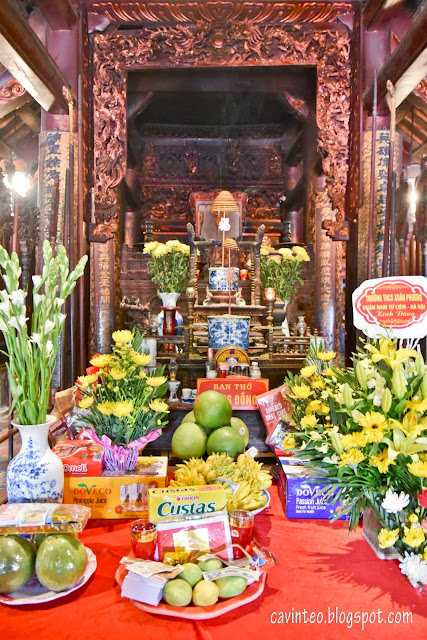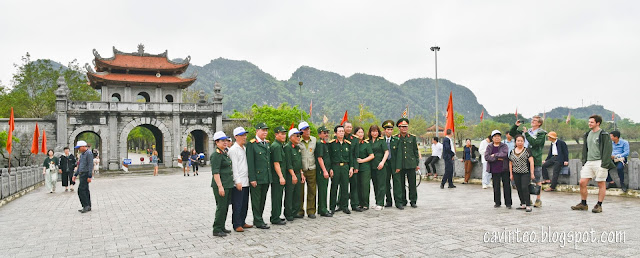An unlikely location for a capital, Hoa Lu was surrounded by limestone mountains, with not much commercial activities. I would think it's better suited to be a summer capital, for vacation, rather than a working one!
Maybe because this ancient capital was more than one thousand years old, developments that could have existed then had all been buried and taken over by this laidback oasis of peace and calm.
Ferocious lion statues guarding the bridge.
Capital of the first feudal monarchy system in Vietnam, Hoa Lu was the seat of political power for about 42 years from 968. Despite this seemingly short tenure, it underwent three regime changes; under the dinh, early le, and ly dynasties.
Underneath the city gate.
With three archways, I was scratching my head on the strange placements of these two modern chairs in the bigger, center one. For Chinese customs, it was said that the central one would be reserved for the kings / emperors. Oh well, I happily entered via the center one.
The inside of this ancient capital citadel felt more like a park! To be fair, the citadel was already non existent and what we see now would be the remnants, including city gates and walls.
Map of the ancient Hoa Lu Capital - it's much bigger than I expected as what we were brought through was in reality just a small section; mainly focused on the Temple of Emperor Đinh Tiên Hoàng.
Pavilion on our right. There was a stone with inscriptions in the middle but I was too lazy to run the 200 meters (to and fro). According to google map, it's called Ly Thai To Stele House. Ly Thai To is the "founding emperor of Lý dynasty".
A decorated water buffalo; guess we need to pay money to take pictures with it. Only problem: I don't see anyone near it within a hundred meters. Maybe operator went for toilet break.
Limestone hill next to us. One of the favorite questions that locals love to ask foreigners like us; could you see the mountain goats?! I definitely didn't see any!
Meridian gate for the Temple of Emperor Đinh Tiên Hoàng. Even though this temple wasn't part of the ancient capital citadel, which exited over millennia ago, it was built four centuries ago, making it older than Singapore, which was founded in 1819.
Let's step in! There's another temple just about 160 meters that honored Emperor Le Dai Hanh, founder of the Early Ly Dynasty. It was smaller than the Temple of Emperor Đinh Tiên Hoàng, and we gave it a miss since architectural wise; both were similar.
This so reminded me of the temple of literature in Hanoi!
This slab of stone was called the dragon bed and although indicated as a national treasure, it didn't seem to be well protected from the weather elements.
Stone lion that didn't look like one.
Walked past the first gate and along the center path where we were flanked by two ponds loaded with koi fishes. Given that lotus is Vietnam's national flower, should there be more lotus ponds?
Second gate.
Beyond second gate; the sides didn't have much until you reach the end, where there were two buildings, one of which would be the exhibition room.
Exhibition room - seemed to be locked up.
Other building was known as the king's parents worshipping room.
Ancestral tablets for the parents of Emperor Đinh Tiên Hoàng. This kind of altar was common amongst the Chinese as a sign of filial piety. While a long time tradition, such practices are being abandoned among the younger generation.
This same building also housed a souvenir section where you can purchase Dua Go Kim Giao; chopsticks made from a type of a tree that's common in Ninh Binh, and said to be able to detect poison (turning to red).
Another side building that had two statues; from the Chinese characters by the sides of the doors, it seemed to honor the empress. Interesting fact about the Empress of Emperor Đinh Tiên Hoàng; she's also the Empress of Emperor Le Dai Hanh; wife of both emperors.
Finally going into the main temple for Emperor Đinh Tiên Hoàng.
You would be forgiven for thinking this was just a normal temple, and not one befitting the status of an emperor. I was expecting one that was a lot grander and majestic.
Typical temple design on the roof; two dragons chasing a sun but in this case, the two dragons seemed more like serpents until you notice the claws.
Another dragon bed in the middle, right in front of the entrance of the temple building. All the while, I thought the dragon bed was literally a bed until I did further research and realize it was more a ceremonial table for which offerings were placed.
This horse statue tempted me to want to sit on top of it, and take a photograph! I could have just jumped up but I am worried I could have flouted the rules. There wasn't any barricade or warning message though...
High step into the temple.
Well, quite a mess within the temple. The words, national treasure, didn't seem to have much bearing. In Singapore, such national treasures would have multiple level of protections to keep off itchy fingers.
Tourists were congregating at the back, where they were stopped by locked doors on both sides of the center altar. They were peering through the window and I was of course curious on what they were looking at.
Statues of the sons of Emperor Đinh Tiên Hoàng; two of which were labelled. One was Đinh Hạng Lang and the other was Đinh Khuông Liễn.
Center would be the statue of Emperor Đinh Tiên Hoàng. Pity we can't go in any further although it doesn't really matter as it's just a wooden statue and not as if we can gain much more knowledge by being nearer to it.
And for a person like Alex who is totally not into history, this kind of visit bores him to death and he's only looking forward to the next leg of the our day tour.
Let's stroll back to the entrance!
=====
Trường Yên, Hoa Lư,
Ninh Bình, Vietnam
Map
As above.
















































No comments:
Post a Comment